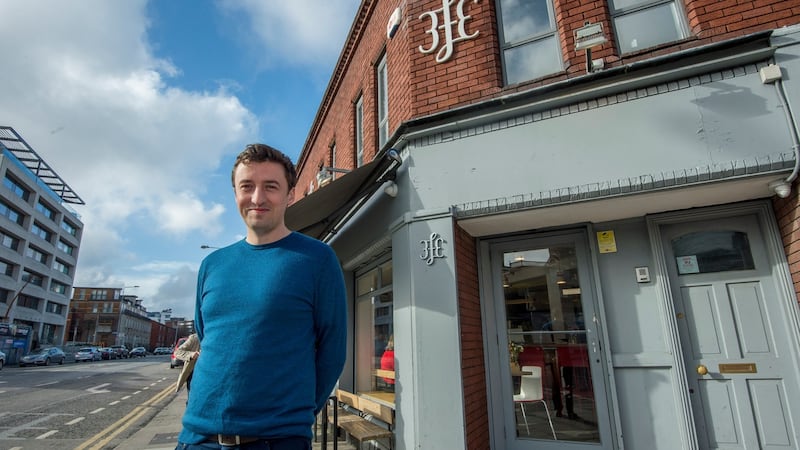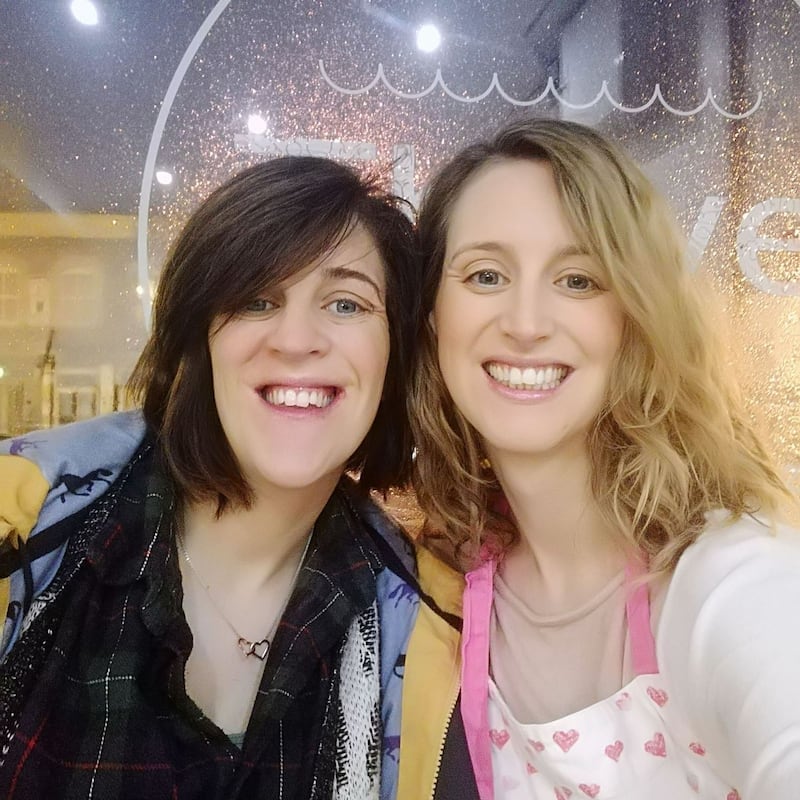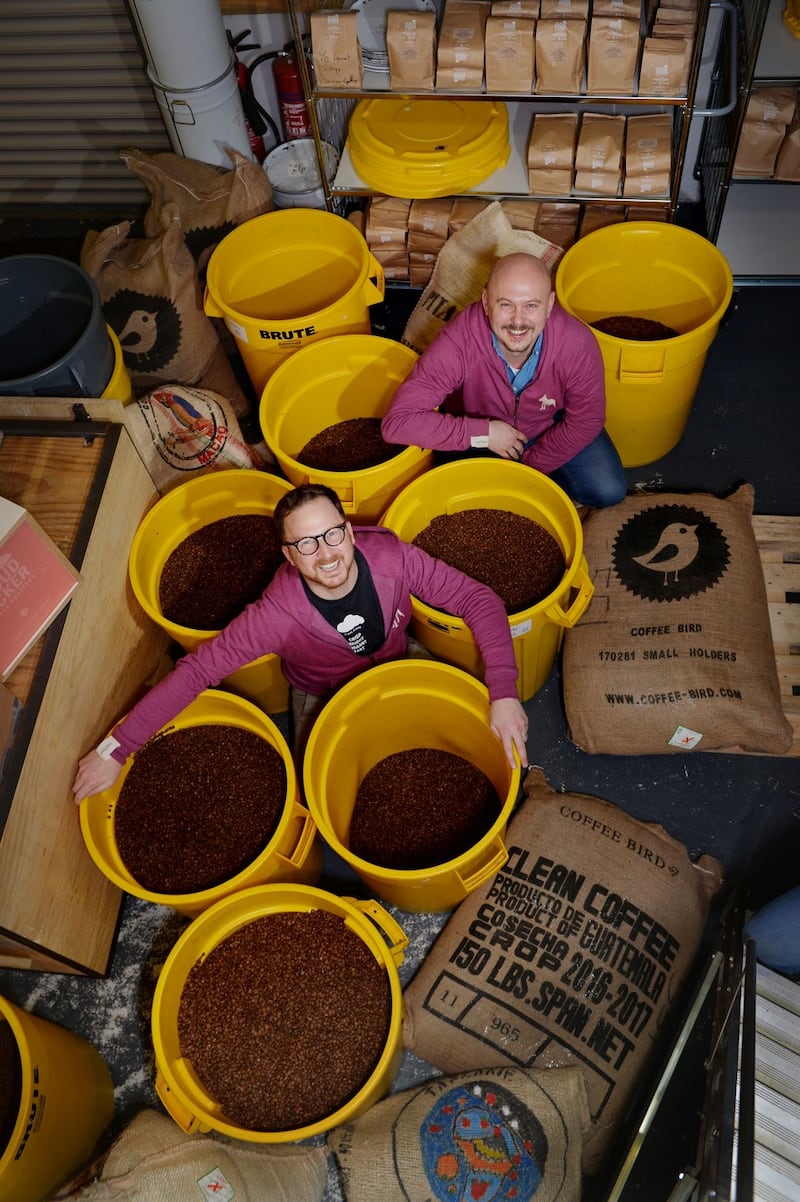You can’t swing a recycled cardboard cup in the capital these days without hitting one of the new generation of gourmet coffee houses. Distinguishable by their enthusiastic use of poured concrete and exposed piping, succulent plants on every table and bicycle parts hanging on the wall, these are places that want you to know they take their coffee seriously.
In practice, “taking their coffee seriously” means eschewing bells, whistles and flavoured syrups for a focus on smaller cups sizes and cooler milk temperatures to draw attention to the flavours in the coffee, which will have been prepared with care by a trained barista, and usually sourced from one of a handful of Irish micro-roasters. You can be sure there isn’t a tub of chantilly cream or a 22oz cup to be found within a 5km radius of any of them.
If Nescafé and Maxwell House represented the first wave of coffee, and the big coffee chains such as Starbucks and Costa the second wave, this is the third wave of the coffee movement – and Irish consumers can’t seem to get enough of it.

One in three Irish people now buys a coffee at least once a day – an increase of 10 per cent on the previous year according to a 2017 survey of 1,011 people by Allegra World for UCC Coffee Ireland. The number of specialist coffee houses grew by 8.5 per cent in 2016, according to Euromonitor, while the overall market for coffee in Ireland will grow by seven per cent over the next five years, UCC predicts.
Seventy per cent of Irish people now drink more than one cup a day. And we’re spending more too – consumers surveyed by UCC said they were willing to spend €3.08 on a great cup of coffee, up 21 per cent since 2013. One in ten would be happy to pay more than €5 on a single cup.
It’s difficult to imagine now, but it is only 20 years since the only Irish people who used the word “cappuccino” were those who wanted you to enquire whether they’d been on holidays to Italy.
Just a couple of decades before that, it actually looked as if coffee might go the way of Bovril – if it hadn’t been for the intervention of Kenneth Roman jr.
Roman, one of the original Mad Men, was the president of the advertising firm Ogilvy & Mather. In 1981, he was invited to speak at a gathering of the Green Coffee Association of New York, on the subject of what to do about the struggling coffee industry. A record frost had hit Brazil in July 1975, pushing coffee prices to levels that consumers simply were no longer willing to pay, and the industry was floundering.
At the convention, Roman made a surprising suggestion. Coffee companies had to stop trying to compete on price, and start selling coffee on the basis of value, image, quality – along with something much more ephemeral.
“We are entering the ‘me’ generation,” he predicted, an era in which consumers would ask crucial questions such as: “What’s in it for me? Is the product ‘me’? Is it consistent with my lifestyle? Does it fill a need?” He urged “coffeemen” to think of what they were selling as an aspirational product that would appeal to different generations and classes, particularly image-conscious yuppies and college students who, at the time, were not drinking coffee at all, preferring to spend their money on sugar-laden soft drinks.
Roman’s prediction proved startlingly prescient. Within a couple of years, smaller, speciality roasters and gourmet coffee houses started to proliferate in US urban areas such as Seattle, New York and San Francisco, and by the second half of the decade, the big commercial producers were bringing out “house blends” and “private blend” instant coffees, designed to impart a more bespoke appeal to yuppies. Meanwhile, Starbucks was spreading its tentacles across Seattle, luring yet-to-be-convinced students with syrups and flavourings to make coffee a more individualistic choice – and more closely resembling those soft drinks they craved.
At around the same time as the TV show Friends was helping to export a version of New York's coffee culture to the rest of the world, a young returning emigrant from Canada was setting up a meeting with his bank manager in Belfast.
Armed with a 50-page business plan, Karl Purdy presented his Swot analysis, his footfall counts, and the demographic profile of his target customer for the business he wanted to set up – a coffee shop – to a bank manager, who was singularly unimpressed.
“We’re in Belfast. We drink tea. A shop that sells only coffee is never going to work,” she told him flatly.
But while she had “zero faith” in his business plan, she was impressed by Purdy, and on that basis she agreed to lend him £10,000. Purdy’s first coffee house, The Ground Floor, was born.
"Friends was on TV, and Sex and the City, so I adopted that kind of feel. I had to have phonetics on the menu to help people pronounce "cappucino" and "caffe latte" and little pencil drawings explaining what they were."
To everyone’s surprise, including, he admits, his own, The Ground Floor was an overnight success. “It came down to luck and serendipity and timing. I opened from 8am until midnight and there were still queues out the door at 9pm to get in.”
It’s because of the success of The Ground Floor – which would give birth to many imitators – that Purdy is frequently credited with bringing sophisticated north American coffee culture to Ireland. Sometimes referred to as the “father of the Irish speciality coffee scene”, he now runs Coffeeangel, which employs more than 35 people and will open its fifth outlet (in the IFSC) in a few weeks’ time.

The trajectory from there to here wasn’t entirely straightforward, however. After The Ground Floor, which was sold after three years for many multiples of Purdy’s initial investment, there was Bond, an ill-fated coffee and wine bar near Dublin’s IFSC, in which, he says, he lost “about a half million euro”.
He was “broken at the end of it, financially and mentally” and it was a few years before he was ready to try again, in a very scaled down way. He borrowed money from a relative and invested in a three-wheel coffee cart. Now, the business plan was just one line long: go where the prams are.
In Dublin at that time, there was one place where there were more prams than any other. He applied for a licence to set up on the end of Howth Pier and opened on St Patrick’s Day, 2004. Over the next seven years, Purdy rediscovered his confidence and learned everything there was to know about coffee and his customers standing shivering at that little cart, first at Howth, later at Dún Laoghaire, and finally in Dublin’s Docklands.
“I treated it like it was a bricks-and-mortar shop. I stood there every day and opened from morning until evening. I refused to pay the rents the Celtic Tiger was demanding, so I waited and stayed true to my business plan, and it worked.”
By 2011, rents had fallen back in the capital, and Purdy was ready to take on a bricks-and-mortar shop again. The first Coffeeangel was a pop-up on South Anne Street that was only supposed to last for three months. That lease was extended to six months, and finally indefinitely. It was followed by more premises on Pembroke Street, and then on Townsend Street.
The speciality coffee industry is “a very simple business. Someone comes in and puts €2 or €3 in front of me, and they need to feel they’ve got a better deal than I have. If they like that deal, they’ll come back the next day. And that’s how the business works”.
During those early years, Coffeeangel became a kind of informal training institute for a new generation of baristas – people who were passionate about coffee, career-focused, creative, frequently well-travelled, and determined to recreate the coffee culture they had experienced in their travels in Ireland.
One of these was Colin Harmon of 3fe. In the late 1990s, “I was working in the IFSC. I had a desk with a nice view, a good salary and a career mapped out for me, and I was bored to tears. I spent all these years working in the hospitality industry to fund my way through college so that I could get a ‘proper job’. And once I had the proper job, I missed the hospitality industry.”

Harmon had always wanted to run his own business “but I never thought I was capable of it. When you’re 16 or 17, your perception of people running a business is that they are these very polished people you see on podiums at events. I didn’t think I fitted that brief. Now I know it takes all kinds. I know plenty of really odd people who are great business people. That’s something I always try to get across when I give a talk.”
He worked in Coffeeangel for a time, and when he was 27, he “just decided to give it a go”. He cobbled together an industrial-sized espresso machine from spare parts in his third-floor apartment – 3fe stands for third-floor espresso – and began training seriously for the barista championships, the Olympics of the coffee world. A year to the day after he quit his job, Harmon came fourth in the world championships.
The first 3fe coffee shop was born not long after, in the front of the Twister Pepper nightclub, with a start-up budget of €5,000. On his first day, he served just 16 cups of coffee, but his obsessive focus on quality and service meant word quickly spread. By 2009, he was wholesaling half a tonne of coffee a week, “and it just made more sense to set up our own roastery”.
These days, the 3fe empire in Dublin includes a second cafe on Suffolk Terrace, a joint venture in Harold’s Cross, an 8,500sq ft roastery in Glasnevin, the barista training school, and an online site whose turnover is up 200 per cent this year. A third cafe on Pearse Street is due to open in the next few months. The wholesale business supplies coffee to gourmet coffee shops around the country and is beginning to make inroads into global markets. Harmon currently employs 45 people; by the end of the year, that number will be close to 60.
The February 2018 Euromonitor report on the Irish coffee industry refers to the “increasing sophistication of the average Irish coffee consumer” which has led to “a significant shift from instant coffee towards premium options”.
When I ask Harman about the more sophisticated tastes of the Irish consumer, he recoils from the term. “I’d be slow to use that word. There’s a perception about 3fe that we’re snooty about coffee, but we’re not. The first bank manager I ever met asked me who my target market was, and I said ‘everybody’, and that hasn’t changed. We supply hipster cafes, but we also supply mom-and-pop places.”
What has changed, he says, is that Irish people no longer regard coffee as purely a source of caffeine. “It’s similar to wine in a sense. If you go to a wine shop instead of just buying wine in the supermarket, it’s for the experience. When people buy coffee it’s for caffeine, but it’s a flavour experience too.”
Harmon is excited by what the revival of the gourmet coffee house can do for rural Ireland. “The communities in rural Ireland used to congregate around the church, the post office, the banks and the pubs, and a lot of those are gone now. I think coffee shops can fill that space.”
One of those on a mission to bring good quality coffee to her corner of rural Ireland is Lorraine Whelan, who, in a testament to just how tight-knit the Irish coffee scene is, was one of Harmon’s early employees at 3fe.
Another refugee from the finance industry, she retrained as a nutritionist and had spent a few years travelling before she turned up at 3fe looking for a job. “Back then, it wasn’t even really about the coffee for me. It was about the space and the community. When I was travelling, coffee shops were really the centre of my social experience, and I was looking to find that in Ireland. And everyone said 3fe was the space.”
She was immediately drawn to the creativity involved in being a barista. “When I started there I didn’t have a knowledge that coffee could be any different than it would be in Starbucks. When I had my first coffee in 3fe, I said aloud, “wow, that’s really nice” and everyone laughed because they could hear my surprise. Making a coffee is an art. It takes time, it takes precision, just like making a cake. There’s a recipe but you can alter that recipe and I found that very creative.”
The year that Harmon came first in the Irish Barista Championships, Whelan came a very close second to her then boss, with a speciality coffee she created using coconut drops. The intention, she says, wasn’t just about flavour, it was to add electrolytes back to the coffee to counter the dehydrating effects.
In 2014, she moved home to Tullow, Co Carlow to be closer to family. She was working as a nutritionist and giving cookery classes, and was terminally “frustrated that there was nowhere good for coffee and food”.
She was five months’ pregnant with her second child when a lease came up on the only cafe in Tullow and together with her sister Helen Demetriou, they decided to go for it. Thrive opened eight weeks ago, bringing with it the same serious approach to coffee she had experienced at 3fe.
“On the first week, people were commenting that our cups were very small. I had anticipated that it was going to be an issue, but I said, no, we’re going to stick with the 8oz.” But after a week of complaints, she gave in and invested in some 12oz cups. “And to this day, we haven’t used one of them. Nobody ever asked the question again. The cups are still there, but we haven’t touched them. Once we explained it, people just got it.”

In tandem with the growth in gourmet coffee shops, a number of new micro-roasteries have opened in recent years. One of the longest established is Cloud Picker, owned by Frank Kavanagh and Peter Sztal, who have been running the cafe in the Science Gallery in Dublin since 2010.
Kavanagh’s background is in graphic design and Sztal’s is in corporate banking, but his passion was always for catering, says Kavanagh. “For the first year and a half at the Science Gallery, we were using an Irish roaster but we couldn’t get the quality we wanted, so we quickly came to the conclusion we could do it ourselves.”
Kavanagh says that if he had known then what he knows now, they wouldn’t have been quite so quick to leap into setting up a micro-roastery. “We didn’t know what we were doing, and we certainly didn’t know we were on the crest of a wave.”
For the first few years, it was a tough graft: “We worked and worked, and everything we earned went back into the company, buying another piece of equipment. There were no rich daddies funding us. I don’t think we’d have done it if we’d known how hard it would be. It’s not easy, whether it’s a cafe or a roastery – you’ve got taxes, you’ve got broken equipment, you’ve got staff issues.”
Now, he says, “it’s amazing to sit back and look around and go, ‘we achieved all this’. There’s seven employees in the roastery, and we’re supplying 80 cafes and businesses around the country. We have Google and Twitter and small restaurants like Oxmantown in Dublin 7, so it’s the full spectrum.”

He defines the Irish coffee scene as “a baby version of London. But being Irish, we don’t half do anything. It’s very fast moving, and there are lots of roasters opening up. If you’re opening up a cafe now, there’s a lot of choice out there. The more competition the better,” he says.
The new generation of micro-roasters will survive by differentiating themselves from the big international producers on the grounds of flavour, quality and traceability, he says. “It’s a completely different product. Right from the quality, to the process that we put it through, we’re echoing that level of quality and level of attention to detail. The big companies are buying low grade, they’re roasting to mask defects, and the result is very generic. We’re all about bringing out the flavour and allowing the natural beauty of the coffee to shine. Our goal is to be the best, but be accessible: great coffee without the snobbishness, without patronising, without any of the preachiness.”
Like Kavanagh, Purdy has no concerns about competition from the relentless march of the big coffee chains. “There will be a lot more chains arriving, they’ll hoover up the premium sites, and that’s fine. There will come a point when landlords appreciate the value of an independent coffee shop, something that’s more authentic. And those teenagers will grow up and realise a smaller drink size is okay, and maybe it doesn’t need whipped cream and syrup.”
The Starbucks and the Costas, he says, “educate people about the coffee industry, and for me, it’s just a matter of being competitive. Irish people know their coffee. I don’t have to phonetically spell out cappuccino anymore; they’ve been to Australia and they know what a flat white is.”
For Purdy, the Irish coffee revolution is about “taking the best of what the world has to offer. It’s irreverent, it has taken the quality of Italy with the creativity of north America and marrying the global cultures with that particular Irish sense of charm.”





















